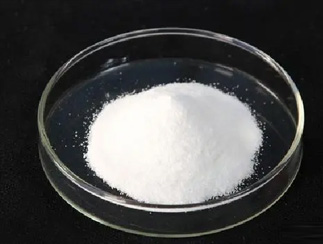Adipic acid, CAS:124-04-9




Adipic acid CAS:124-04-9
Adipic acid
CAS: 124-04-9
Purity: ≥ 99.8%
English name Adipic acid
Adipic acid, also known as fatty acid, is a carboxylic acid
organic compound that can be used as a chemical reagent, as well as in
plastics and organic synthesis.. It is a white crystalline powder,
slightly soluble in water, and acidic when dissolved in water. Adipic
acid, as the basic component unit of various chemical products, is
currently the most important aliphatic dicarboxylic acid in industrial
chemistry production. Approximately 3 million tons of adipic acid are
used worldwide each year to synthesize monomers for nylon-66. In
addition, adipic acid is also used to synthesize polyesters,
polyurethanes, lubricants, plasticizers, adiponitriles, and as a
flavoring agent in food.
Adipic acid English synonyms
RARECHEM AL BO 0180;AKOS BBS-00004308;ADIPIC ACID;adipinic acid;1,6-HEXANEDIOIC ACID;1,4-BUTANEDICARBOXYLIC ACID;BUTANE-1,4-DICARBOXYLIC ACID;DICARBOXYLIC ACID C6.
Adipic acid, or more formally hexanedioic acid, is a white crystalline solid that melts at 152 oC. It is one of the most important monomers in the polymer industry.
Adipic acid is found in beet juice, but the article of commerce—≈2.5 million tonnes of it per year—is manufactured. In 1906, French chemists L. Bouveault and R. Locquin reported that adipic acid can be produced by oxidizing cyclohexanol. Today, the most common manufacturing process is the nitric acid (HNO3) oxidation of a cyclohexanol–cyclohexanone mixture called KA (for ketone–alcohol) oil.
Almost all adipic acid is used as a comonomer with hexamethylenediamine to produce nylon 6-6. It is also used to manufacture other polymers such as polyurethanes.
Using HNO3 to produce adipic acid has its downside: Copious amounts of nitrous oxide (N2O), a greenhouse gas, are coproduced and released into the atmosphere. In late 2014, K. C. Hwang and A. Sagadevan of National Tsing Hua University (Hsinchu City, Taiwan) reported a process that uses ozone and ultraviolet (UV) light to oxidize KA oil to adipic acid. This method eliminates the production of N2O; but before the process can be used commercially, problems associated with the formation of organic peroxides from ozone and the difficulty of using UV light on a large scale must be overcome.
Adipic acid Application:
Adipic acid is the most valuable dicarboxylic acid among fatty acids. Adipic acid has the properties of aliphatic dicarboxylic acids, including salt formation reaction, esterification reaction, amidation reaction, etc. The main use of adipic acid is as a raw material for three major categories of products, namely: synthesizing nylon 66 salt, and then producing polyamide resin and fiber (nylon 66) in Chemicalbook. Nylon 66 is the largest end market for adipic acid; Synthesis of polyester polyols for the production of polyester polyurethane; Adipic acid diester plasticizer. In addition, it can also be used to produce advanced lubricants and food additives (souring agents for food and beverages).
Adipic acid Usage limit:
GB2760-96: Solid beverage, 0.01g/kg; Chewing gum
4.0mg/kg; Jelly powder, 0.15g/kg (diluted 6 times); Food flavorings.
FDA, § 184.1009 (1994): Baked goods, 0.05%; Non alcoholic beverages,
0.005%; Seasoning, Chemicalbook 5.0%; Dairy products, 0.45%; Oil 0.3%;
Frozen milk desserts, 0.0004%; Gelatin and pudding, 0.55%; Meat juice,
0.1%; Meat products, 0.3%; Snack food, 1.3%; Other foods, 0.02%. FEMA
(mg/kg): Soft drinks 40, pudding 5000.
Adipic acid Chemical properties:
White crystalline body with a burnt bone
odor. Slightly soluble in water, easily soluble in most organic solvents
such as alcohol and ether.
Adipic acid Usage:
Used as a raw material for synthesizing polymers, as well as for making plasticizers and lubricants
Organic synthesis, soldering flux, resin making, plastics.
Mainly used as raw materials for nylon 66 and engineering
plastics, it is also used in the production of various ester products
and as a raw material for polyurethane elastomers
Jidi acid has a soft and persistent sour taste, with minimal
changes in pH values over a large concentration range, making it a good
pH regulator. Can be used for jelly powder and solid beverage powder,
with maximum usage amounts of 0.15g/kg and 0.01g/kg, respectively.
The primary use is as a raw material for nylon 66 and engineering plastics. Secondly, it is used for the production of various ester products, as plasticizers and advanced lubricants. In addition, adipic acid is also used as a raw material for polyurethane elastomers and as an acidifying agent for various foods and beverages, sometimes surpassing citric acid and tartaric acid. Adipic acid is also a raw material for pharmaceuticals, yeast purification, insecticides, adhesives, synthetic leather, synthetic dyes, and fragrances.




































Wechat:Customer
